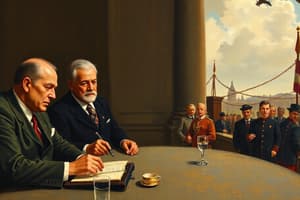Podcast
Questions and Answers
Who was George Kennan?
Who was George Kennan?
American diplomat to the Soviet Union who was a key advisor to President Truman.
Who was George Marshall?
Who was George Marshall?
Secretary of State who was chosen to head the US aid program to European nations.
Who was Joseph Stalin?
Who was Joseph Stalin?
Ruthless dictator of the Soviet Union determined to establish communism throughout Europe.
Who was Molotov?
Who was Molotov?
Who was Winston Churchill?
Who was Winston Churchill?
Name two reasons Truman wanted to rebuild European economies.
Name two reasons Truman wanted to rebuild European economies.
What was the Truman Doctrine?
What was the Truman Doctrine?
Which two countries were threatened by communism?
Which two countries were threatened by communism?
Why was the Truman Doctrine significant?
Why was the Truman Doctrine significant?
Name two consequences of the Truman Doctrine.
Name two consequences of the Truman Doctrine.
What was the main purpose of the Marshall Plan?
What was the main purpose of the Marshall Plan?
Name similarities and differences of the Truman Doctrine and Marshall Plan.
Name similarities and differences of the Truman Doctrine and Marshall Plan.
Flashcards are hidden until you start studying
Study Notes
Key Figures
- George Kennan: American diplomat in the Soviet Union and key advisor to President Truman.
- George Marshall: Secretary of State, led the U.S. aid program to assist European nations post-WWII.
- Joseph Stalin: Dictator of the Soviet Union, aimed to promote communism across Europe.
- V.M. Molotov: Soviet ambassador to the United Nations, known for unwavering loyalty to Stalin.
- Winston Churchill: Prime Minister of Great Britain, delivered the "Iron Curtain" speech in March 1946, highlighting the division between Western democracies and Eastern communist countries.
Truman Doctrine
- A policy asserting U.S. support for any nation threatened by communism.
- Aimed to counter Soviet influence in regions like Greece and Turkey, considered critical to U.S. strategic interests.
- Marked the end of U.S. isolationism and signified a commitment to international intervention.
Significance of the Truman Doctrine
- Altered U.S. foreign policy by engaging directly in global affairs, moving away from a non-interventionist stance.
- Spurred competition and rivalry with the Soviet Union, escalating the Cold War.
Consequences of the Truman Doctrine
- Increased tensions between the U.S. and the Soviet Union.
- Set the precedent for providing economic aid to bolster European countries against communist threats.
Marshall Plan
- Intended to restore European economies after WWII, vital for preventing the spread of communism.
- Focused on economic recovery, distinguishing it from military or strategic support.
Comparison of Truman Doctrine and Marshall Plan
- Similarities:
- Both aimed to thwart the spread of communism.
- Both involved financial aid to European nations.
- Differences:
- The Truman Doctrine included military support; the Marshall Plan was strictly economic.
- The Marshall Plan extended aid to all European nations, while the Truman Doctrine was limited to Greece and Turkey.
Studying That Suits You
Use AI to generate personalized quizzes and flashcards to suit your learning preferences.




